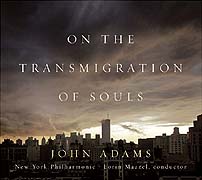| Artist: John Adams Album: On the Transmigration of Souls Released: 31 August 2004 |  
|
|
On the Transmigration of Souls by John Adams commemorates those who lost their lives on the 11 September 2001 attack on the World Trade Center. It also mourns on behalf of those of us left behind. This work is without any contemplation of motive; it is about the nature of death and has been cited as the finest musical representation of this concept since the adagio from Mahler's Fourth. On the Transmigration of Souls was given its premiere by the New York Philharmonic on 19 September 2002 at Lincoln Center. The CD presents a stereophonic recording of Adams work.
According to Adams, "Transmigration means 'the movement from one place to another' or 'the transition from one state of being to another.' But in this case I mean it to imply the movement of the soul from one state to another. And I don't just mean the transition from living to dead, but also the change that takes place within the souls of those that stay behind, of those who suffer pain and loss and then themselves come away from that experience transformed." On the Transmigration of Souls contains no musical narrative. It refers not to any externalities, but to loss and grief, to our slowly dimming acceptance of reality and of movement into light. This work is a musical space for reflection and remembrance, of meditation on an unanswerable question. Adams has described the piece as "a memory space" where each listener can find their own personal response. This challenging 25-minute work takes Adams' complex sound into a spiritual realm. It combines ambient city sounds and live performances by a children's chorus, an adult chorus, and a large orchestra - with choral texts, a litany of victims, taken from newspaper memorials and the desperate missing-person fliers pervading lower Manhattan in the months following the attacks. The verbal heartbeat of the soundtrack literally surrounds the audience. This seemingly unorganized passage is actually set in a careful therapeutic course - illustrating that from out of the mundane (a clear Tuesday morning) comes the profound. Adams also gave the symphony orchestra, a 19th-century artifact, a 21st-century sound. His metallic, post-industrial style is far from the traditionally lush impressionistic palette. By stacking layers of instrumental oscillations and pulses, the orchestra shimmers. The density of sound and texture; disjunt, nondirectional and dissonant, and the emphasis on the bright upper register make the live orchestra seem electronically synthesized. One reason the September 11th atrocities are still with us is that we have learned to bury them in a mass of other facts. Adams' music makes these unsettling emotions vibrate with troubling energy. In the span of 25 minutes he manages to encompass anger, grief and the enormity of the tragedy - in hopes of leading us beyond the complexities of world events to a state of peacefulness. New "serious classical" music remains nearly as marginal as it was during its prime. But this mode of expression is becoming more spiritual and more relevant to us. On the Transmigration of Souls is unequaled in its poignancy and optimism, and in its capacity to pose the eternal question of existence. This poignant, minimalist memorial is a non-exploitive work of art where people can go to meditate upon their feelings and emotions - the fulfillment of music's ability to move. - STAR'S END 3 September 2004 | |